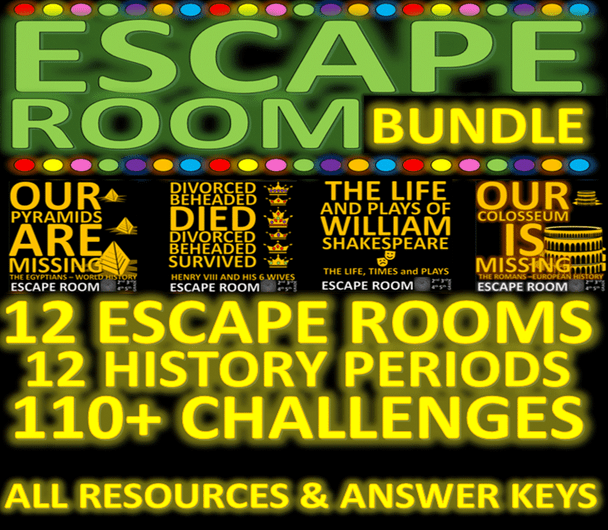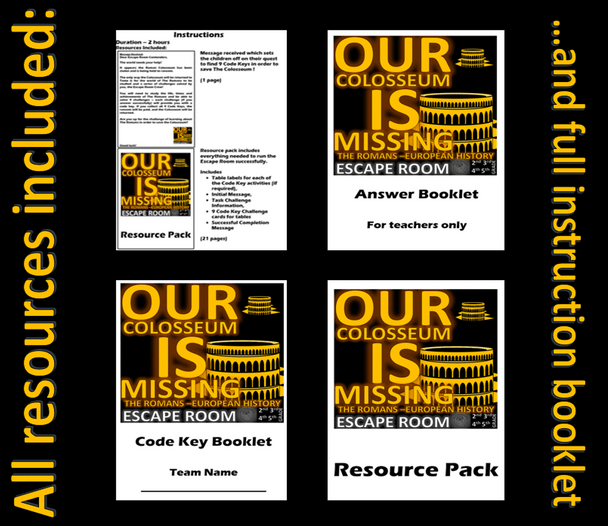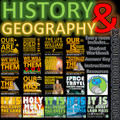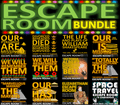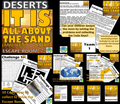Description
This product brings together 18 of our popular Escape Rooms in History and Geography. Covering a vast array of topics within the 2nd- 6th Grade curricula, they provide a unique, exciting and interesting way of teaching these topics. Whether you are teaching the Aztecs, Mayans, Egyptians, Oceans, Rainforests, Mountains or even Deserts - these Escape Rooms can introduce, conclude or be a stand alone activity for your teaching.
Included within this bundle are the following Escape Room topics:
The 12 history periods included are:
- Ancient Egyptians
- Tudors
- William Shakespeare and his plays
- Romans
- Aztecs
- Ancient Greeks
- Victorians
- Space Race
- World War 1
- World War 2
- Elizabethans
- Mayans
The 7 Geography themes are:
- Volcanoes
- Rainforests
- Deserts
- Oceans
- Continents
- Mountain
- World Rivers
- The Water Cycle
Using an Escape Room to develop curriculum knowledge is an exciting activity that will inspire learners from 3rd Grade to 6th Grade (and beyond depending on the level of the learner and the subject being developed).
The curriculum content for each is listed on the description of each product- each Escape Room comes with a complete set of instructions and curriculum coverage overview with each challenge as well as:
- Answer Key Booklet
- Code Key Booklet (for students to complete in teams/or individually)
- Resource Pack
- Full instructions for holding an Escape Room in your classroom/home
- Team Table Labels
- Opening and Closing Script to set up and conclude the Escape Rooms
Ancient Egyptians: Curriculum Coverage
The 9 activities are based on the following outcomes:
- Word Search to introduce 25 key words related to the life of the Ancient Egyptians – as well as an extra secret hidden word which is the Code Key to move to Challenge 2.
- Crossword which introduces facts about the life of the Egyptians
- Timeline of key events within the Ancient Egyptians, including the discovery of Tutankhamun’s tomb by Howard Carter
- The use of Canopic Jars, their names, their appearance and what they held
- Sequencing the process of Mummification
- Egyptian society – who belongs where?
- Seasons on the Nile, the time of year and what the season was used for
- True or False – based on the challenges completed so far
- Review of learning - Quiz
The Tudors and Henry VIII: Curriculum Coverage
The 8 activities are based on the following outcomes:
- Word Search to introduce 30 key words related to the life of Henry VIII
- Word search which introduces facts about the life of Henry VIII
- Timeline of key events within the life of Henry VIII
- Ordering the wives and their marriages, along with adding the fate of each one – making sense of the rhyme, divorced, beheaded, died, divorced, beheaded, survived (the name of this Escape Room)
- Memorising the names and order of the wives of Henry and his three children
- Creating a family tree of Henry, his wives, the dates of marriages, the children and the dates they were born
- True and false statements relating to the life of Henry VIII, with the children having to justify why a statement is false by giving the correct response from their completion of previous challenges.
- Review of learning - Quiz
William Shakespeare - Life, Times and Plays: Curriculum Coverage
The 9 activities are based on the following outcomes:
- Word Search to introduce 29 key words related to the plays of William Shakespeare
- Word search which introduces facts about the life of William Shakespeare
- Timeline of plays written by William Shakespeare
- 16 famous pairs of characters within the plays of Shakespeare
- Places which are linked to the plays of William Shakespeare throughout the world
- True and false statements relating to the life of Shakespeare, with the children having to justify why a statement is false by giving the correct response from their completion of previous challenges.
- Famous quotes and the plays which they come from – letter sort
- Sorting a timeline into chronological order of the life events of William Shakespeare
- Review of learning - Quiz
Roman Escape Room: Curriculum Coverage
The 9 activities are based on the following outcomes:
- Word Search to introduce 25 key words related to the life of The Romans – as well as an extra secret hidden word which is the Code Key to move to Challenge 2.
- Crossword which introduces facts about the life of The Romans
- Timeline of key events within The Romans
- Roman Gods and their roles in the lives of The Romans
- Roman Language – Root Words and how we use them today
- Roman Society – who belongs where?
- Roman Numerals
- Roman Army
- Roman Inventions
Aztecs Escape Room: Curriculum Coverage
The 9 activities are based on the following outcomes:
- Word Search to introduce 25 key words related to the life of The Aztecs – as well as an extra secret hidden word which is the Code Key to move to Challenge 2.
- Crossword which introduces facts about the life of The Aztecs
- Timeline of key events within The Aztecs, including the arrival of the Spanish Conquistadors.
- The role and importance of the ten most prominent Aztec Gods
- The roles of different people, men, women, children, slaves and priests within Aztec society
- The social pyramid of Aztec Society
- The number system – and solving a growing complexity of ten math questions using the number system
- Sequencing the events which led to the downfall of The Aztecs
- The invention of chocolate (within a drink) and the importance the cocoa bean had within Aztec society.
The Ancient Greeks: Our Parthenon has gone! Curriculum Coverage
The 9 activities are based on the following outcomes:
- Word Search to introduce 27 key words related to the Ancient Greeks – as well as finding a secret word which is hidden and is Code Key 1 which the children must find to move to Challenge 2.
- Crossword to complete which introduces further Greek information to the children – there are 14 clues to solve.
- Timeline of key events within the Ancient Greek Period from start to Roman rule
- The names and roles of the top 10 Ancient Greek Gods
- Root word investigation and their meanings used today from the Ancient Greek
- The difference between Athenian and Spartan society – using hierarchical social pyramids. Comparison between the two.
- Greek Alphabet – symbols and names
- Aesop’s Fables – Complete the title of the fable
- Ancient Greek Engineering and Invention
The Victorians Escape Room - Curriculum Coverage
The 8 activities are based on the following outcomes:
- Word Search to introduce 30 key words related The Victorians ensuring that children develop a wide vocabulary when discussing key events, people and elements of the Victorians.
- Crossword to complete which introduces further important information to the children – there are 12 clues to solve.
- Timeline of Queen Victoria’s life
- Timeline of Inventions and engineering developments during the Victorian period
- Impact of Inventions on Victorian life and life today
- Linking engineers and inventors to their inventions
- Queen Victoria’s family tree, sequencing her nine children and identifying the family line to Queen Elizabeth II today
- A Victorian Christmas – developments and new traditions
- The achievements of Isambard Kingdom Brunel
The Space Race 1961 - 2020
The 10 activities are based on the following outcomes:
- Word Search to introduce 28 key words related to The Space Race, introducing the students to the names of key astronauts, cosmonauts and space-based terminology.
- Crossword to complete which introduces further important information to the students – there are 12 clues to solve.
- Space Race timeline stretching from 1961 – 2020.
- Timeline of astronauts, cosmonauts and their ground-breaking “first” achievements.
- Matching activity linking astronauts and cosmonauts to their achievements.
- Space Race – which country achieved which “groundbreaking event” first?
- Ordering the planets in the solar system.
- True of False statements – students to correct the false statements with accurate information gained from previous Challenges within this Escape Room.
- Distance from Earth – Planets in the Solar System
- Space Race – which country achieved which “ground-breaking event” first?
- Eight facts and pieces of knowledge which the students have learnt as a result of completing this Escape Room.
Space Race – which country achieved which “ground-breaking event” first?ork under pressure to solve a range of clues to in order to save the world, escape from a situations or learn more about the subject matter (historical periods).
World War 1 Escape Room
The 10 activities are based on the following outcomes:
- Word Search to introduce 33 key words related World War I – ensuring that children develop a wide vocabulary when discussing key events, leaders and elements of World War I. There is a secret word for the children to find which is the Code Key to move to Challenge 2 (Poppies)
- Crossword to complete which introduces further important information to the children – there are 14 clues to solve.
- Timeline of key events leading up to and within the first month of World War I
- Allied Powers and Central Powers – Who was on which team?
- Leaders and their Countries
- Archduke Franz Ferdinand – Why was his death so influential in the start of World War 1?
- RMS Lusitania – Why was the sinking of this ship so vital to the achievements of the Allied forces in World War 1?
- World War 1 in numbers (multi-choice response questions)
- End of World War 1 Cloze Procedure
- End of Challenge Quiz – 9 Questions and Multi-choice answers.
World War 2 Escape Room
The 9 activities are based on the following outcomes:
- Word Search to introduce 33 key words related World War II – ensuring that children develop a wide vocabulary when discussing key events, leaders and elements of World War II. There is a secret word for the children to find which is the Code Key to move to Challenge 2 (Remembrance)
- Crossword to complete which introduces further important information to the children – there are 15 clues to solve.
- Timeline of key events leading up to and within World War II
- Allied Forces and Axis Countries
- Leaders and their Countries
- The build up to World War II
- World War II outcomes in numbers
- Aircraft – linking makes, country of design and interesting facts
- Pearl Harbour Cloze Procedure
The Elizabethans Escape Room
The 8 activities are based on the following outcomes:
- Word Search to introduce 29 key words related The Elizabethans ensuring that children develop a wide vocabulary when discussing key events, people and elements of the Elizabethans.
- Crossword to complete which introduces further important information to the children – there are 13 clues to solve.
- Timeline of Queen Elizabeth’s life
- Tudor Family Tree, Henry VIII, wives and children
- Explorers and their discoveries
- Tudor Food – True and False statements
- Explorers and their achievements (2)
- Know your explorers
Marvellous Mayans Escape Room
The 9 activities are based on the following outcomes:
- Word Search to introduce 25 key words related to the life of The Mayans – as well as an extra secret hidden word which is the Code Key to move to Challenge 2.
- Crossword which introduces facts about the life of The Mayans
- Timeline of key events within The Mayans, including the arrival of the Spanish Conquistadors.
- The role and importance of the most prominent Mayan Gods
- The roles of different people, men, women, children and priests within Mayan society
- The social pyramid of the Mayan Society
- The number system – and solving a growing complexity of ten math questions using the number system
- Sequencing the events which led to the downfall of The Mayans
- The invention of chocolate (within a drink) and the importance the cocoa bean had within Mayan society.
The contents of each Geography Escape Room is as follows for the current published rooms:
Volcanoes: Holy Moly - It's Alive!
The 10 activities are based on the following outcomes:
- Word Search to introduce 27 key words related Volcanoes ensuring that children develop a wide vocabulary. There is also an extra hidden word which the children must find in order to solve the Code Key and move to the next challenge.
- Crossword to complete which introduces further important information to the children – there are 10 clues to solve.
- Labelling a cross section of a volcano using 8 key features
- Date, name of volcano and global position of the 6 biggest eruptions in world history
- The Ring of Fire – add the missing words to make the text make sense
- Where in the World? Identifying the Ring of Fire and 6 main volcanoes on a map of the world
- Sequencing the events leading up to a volcanic eruption – what to look for and what will happen next
- Features of three different types of volcanoes
- Identifying global volcanoes in one of the three different types
- True or False – final challenge using the knowledge gained within this Escape Room – 10 statements.
Rainforests: It Is All About the Trees!
The 10 activities are based on the following outcomes:
- Word Search to introduce 31 key words related Rainforests ensuring that children develop a wide vocabulary. There is also an extra hidden word which the children must find in order to solve the Code Key and move to the next challenge.
- Crossword to complete which introduces further important information to the children – there are 14 clues to solve.
- Labelling a cross section of a rainforest with the different layers and the correct amount of sunshine each levels receive.
- Name of the rainforests across the planet and their global position
- Importance of rainforests – add the missing words to make the text make sense
- Where in the World? Identifying Rainforests on a map of the world
- How trees produce oxygen
- Difference between temperate and tropical rainforests
- True or False? Final challenge using the knowledge gained within this Escape Room – 10 statements.
Deserts: It Is All About the Sand - and Ice!
The 10 activities are based on the following outcomes:
- Word Search to introduce 25 key words related Deserts ensuring that children develop a wide vocabulary. There is also an extra hidden word which the children must find in order to solve the Code Key and move to the next challenge.
- Crossword to complete which introduces further important information to the children – there are 12 clues to solve.
- Labelling an image of a desert with 6 key features
- Linking the names and global position of 10 of the world’s biggest Deserts
- What is a desert? – add the missing words to make the text make sense
- Where in the World? Identifying key lines on world map (Tropics of Cancer, Capricorn and Equator) and 9 key deserts in the world on a world map
- Linking the size of deserts with their names
- Matching the features of four different types of deserts to the correct desert and introducing students to the notion that both the Arctic and Antarctic are deserts due to their lack of rainfall and access to water
- Identifying which desert falls into which of the four desert types
- True or False – final challenge using the knowledge gained within this Escape Room – 10 statements.
Oceans: It's all about the water!
The 10 activities are based on the following outcomes:
- Word Search to introduce 25 key words related Oceans ensuring that children develop a wide vocabulary. There is also an extra hidden word which the children must find in order to solve the Code Key and move to the next challenge.
- Crossword to complete which introduces further important information to the children – there are 15 clues to solve.
- Labelling a cross section of an ocean with 8 key features identified (surface, continental slope, rise and shelf, abyssal plain, oceanic trench, volcanic island and mid-ocean ridge)
- Linking the names and global position of the 5 oceans of the world
- Oceans – Cloze Procedure – add the missing words to make the text make sense – oceans, movement of water, structure and importance to life on Earth
- Where in the World? Identifying key lines on world map (Tropics of Cancer, Capricorn and Equator) and the positions of the 5 World Oceans
- Linking the size of oceans with their names and sequencing the oceans from largest to smallest
- Vocabulary of water bodies and their definitions (ocean, sea, river, lake, stream, pond, rockpool, swamp)
- Facts about oceans – guess the ocean from the fact given (position, size, features, comparison with other oceans)
- True or False – final challenge using the knowledge gained within this Escape Room – 10 statements.
Continents: It's all about the land mass!
The 9 activities are based on the following outcomes:
- Word Search to introduce 25 key words related to Continents ensuring that children develop a wide vocabulary. There is also an extra hidden word which the children must find in order to solve the Code Key and move to the next challenge.
- Crossword to complete which introduces further important information to the children – there are 15 clues to solve.
- Linking the names and global position of the 7 continents of the world
- Continents – Cloze Procedure – add the missing words to make the text make sense
- Where in the World? Identifying key lines on world map (Tropics of Cancer, Capricorn and Equator) and the positions of the 7 Continents
- Linking the size of continents with their names and sequencing the continents from largest to smallest – population and land mass
- Vocabulary of land masses (plate tectonic, continent, archipelago, basin, desert, fault, island, mountain)
- Facts about continents – guess the continent from the fact given (position, size, features, comparison with other continents)
- True or False – final challenge using the knowledge gained within this Escape Room – 10 statements.
Mountains: It's all about the peak!
The 9 activities are based on the following outcomes:
- Word Search to introduce 25 key words related Mountains ensuring that children develop a wide vocabulary. There is also an extra hidden word which the children must find in order to solve the Code Key and move to the next challenge.
- Crossword to complete which introduces further important information to the children – there are 13 clues to solve.
- Linking the names and global position of the main mountain ranges of the world
- Mountains – Cloze Procedure – add the missing words to make the text make sense – mountains, creation, ranges and some facts involved with specific ranges
- Where in the World? Identifying key lines on world map (Tropics of Cancer, Capricorn and Equator) and the positions of key mountain ranges in the world
- Vocabulary of mountains and their definitions
- Facts about mountain ranges – guess the mountain range from the fact given (position, size, features, comparison with other ranges)
- True or False – final challenge using the knowledge gained within this Escape Room – 10 statements.
Rivers : It's all about the water!
The 10 activities are based on the following outcomes:
- Word Search to introduce 25 key words related Rivers ensuring that children develop a wide vocabulary. There is also an extra hidden word which the children must find in order to solve the Code Key and move to the next challenge.
- Crossword to complete which introduces further important information to the children – there are 15 clues to solve.
- Labelling a cross section of a river with 9 key features identified (source, mouth, ocean/sea, estuary, delta, ox bow lakes, flood plain, tributary, meander)
- Linking the names and global continent position of 15 rivers in the world
- Rivers – Cloze Procedure – add the missing words to make the text make sense – journey of a river from source to mouth using the key vocabulary
- Where in the World? Identifying the position of 16 major rivers in the world
- Linking the size of rivers to their lengths
- Vocabulary of water bodies and their definitions (ocean, sea, river, lake, stream, pond, rockpool, swamp)
- Facts about rivers – guess the river from the fact given (position, size, mouth position, comparison with other oceans)
- True or False – final challenge using the knowledge gained within this Escape Room – 10 statements.
It's all about the Cycle - The Water Cycle
The 10 activities are based on the following outcomes:
- Word Search to introduce 25 key words related to the Water Cycle ensuring that children develop a wide vocabulary. There is also an extra hidden word which the children must find in order to solve the Code Key and move to the next challenge.
- Crossword to complete which introduces further important information to the children – there are 13 clues to solve.
- Linking scientific vocabulary to their definitions – 5 words integral to the Water Cycle
- Labelling a scientific diagram of a cross section of the Earth – adding on 6 key terms within the water cycle – in action in the diagram.
- Linking the names and global continent position of 12 deserts in the world, and explaining how their position in the world impacts on their geographical features.
- The Water Cycle – Cloze Procedure – add the missing words to make the text make sense – the processes in the Water Cycle
- Where in the World? Identifying the position of 12 major deserts in the world and explaining how their position influences their conditions (equatorial links)
- What will happen next – predicting the processes which will occur in real-life scenarios and why.
- Vocabulary of water bodies and their definitions (ocean, sea, river, lake, stream, pond, rockpool, swamp)
- Real life processes – given 14 scenarios, students to select the processes involved within the water cycle from evaporation, condensation, transpiration, infiltration or precipitation – or a mixture of more than one!
- True or False – final challenge using the knowledge gained within this Escape Room – 10 statements.
Setting up the Escape Room
1. Children should be split into groups of no more than four and be placed in their own workspace.
2. Access to IT and research materials should be provided to allow children to research answers to questions and review their own knowledge, as well as checking answers.
3. Each group should have a Code Key Booklet and decide on a team name
4. Read the Initial Message to the children to set the challenge in context. Discuss what this means, and what the activity entails.
5. Turn to Code Key 1. Agree with the children a set time to complete the problem in – this ensures that the children stay on task and maintains the Escape Room element of working under pressure.
6. At the end of the time, children should have filled in the Code Key in their booklet. The teacher can then check the accuracy of all the groups and talk through the responses the children should have.
7. Move on through the remaining challenges until all 10 have been completed.
8. For those groups who have been successful, they are then able to read the completed statement where they find out if they have escaped the Escape Room!
There are other ways of running Escape Room activities, for example, each activity could be set up on 10 tables and the children then move from table to table completing the activity. This would reduce the need for as many resources, and access to non-fiction sources and Internet Resources could then be targeted at specific Challenges.
Each Escape Room should last for at least 2 hours.
We hope that your children enjoy these Escape Rooms.
Thank you for visiting our store.
Best wishes
INSPIReducation



